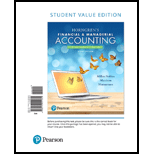
Concept explainers
2. and 3.
Accounting Cycle: The accounting cycle refers to the entire process of recording the accounting transactions of an organization and then processing them. The accounting cycle starts when a transaction takes places and it ends at the time when these transactions are recorded in the financial statements of the company.
The following are the rules of debit and credit:
- 1. Increase in assets and expenses accounts are debited. Decrease in liabilities and
stockholders’ equity accounts are debited. - 2. Increase in liabilities, revenues, and stockholders’ equity accounts are credited. Decreases in all asset accounts are credited.
To Record: The adjusting journal entries in books during December.
1. 2. And 3
T Accounts: T- accounts are prepared for all the business transactions. First, journal entries are passed and then transferred to the respective ledger accounts where they are recorded, and summarized in either side of the ‘T’ format. It is divided into two parts by a vertical line, that is, the left side and the right side. The left side of the T-account is known as the debit side, and the right side of the T-account is known as the credit side. The account name appears on the top of the T-account.
To Post: The above journal entries and
(3)
Prepare trial balance for C Company as on December 31, 2018.
(4)
To Prepare: The income statement,
5.
Gross profit percentage is the financial ratio that shows the relationship between the gross profit and net sales. Gross profit is the difference between the total revenues and cost of goods sold. It is calculated by using the following formula:
To Calculate: The gross profit percentage of Company C.
Want to see the full answer?
Check out a sample textbook solution
Chapter 5 Solutions
Horngren's Financial & Managerial Accounting, The Managerial Chapters, Student Value Edition (6th Edition)
- What is the percent change in sales for year 2 compared to the base year of this financial accounting question?arrow_forwardPhoenix Industries has twelve million shares outstanding, generates free cash flows of $75 million each year, and has a cost of capital of 12%. It also has $50 million of cash on hand. Phoenix wants to decide whether to repurchase stock or invest the cash in a project that generates free cash flows of $3 million each year. Should Phoenix invest or repurchase the shares? A) Repurchase B) Invest C) Indifferent between options D) Cannot say for sure provide answerarrow_forwardprovide correct answerarrow_forward
- abc general accountingarrow_forwardStep by step answerarrow_forwardAt the beginning of the year, Anderson Corporation's assets are $275,000 and its equity is $198,000. During the year, assets increase by $95,000 and liabilities increase by $58,000. What is the equity at the end of the year? Helparrow_forward
- Morgan & Co. is currently an all-equity firm with 100,000 shares of stock outstanding at a market price of $30 per share. The company's earnings before interest and taxes are $120,000. Morgan & Co. has decided to add leverage to its financial operations by issuing $750,000 of debt at an 8% interest rate. This $750,000 will be used to repurchase shares of stock. You own 2,500 shares of Morgan & Co. stock. You also loan out funds at an 8% interest rate. How many of your shares of stock in Morgan & Co. must you sell to offset the leverage that the firm is assuming? Assume that you loan out all of the funds you receive from the sale of your stock.arrow_forwardWhat is the new price after the mark up for this financial accounting question?arrow_forwardhi expert please help me financial accountingarrow_forward

 AccountingAccountingISBN:9781337272094Author:WARREN, Carl S., Reeve, James M., Duchac, Jonathan E.Publisher:Cengage Learning,
AccountingAccountingISBN:9781337272094Author:WARREN, Carl S., Reeve, James M., Duchac, Jonathan E.Publisher:Cengage Learning, Accounting Information SystemsAccountingISBN:9781337619202Author:Hall, James A.Publisher:Cengage Learning,
Accounting Information SystemsAccountingISBN:9781337619202Author:Hall, James A.Publisher:Cengage Learning, Horngren's Cost Accounting: A Managerial Emphasis...AccountingISBN:9780134475585Author:Srikant M. Datar, Madhav V. RajanPublisher:PEARSON
Horngren's Cost Accounting: A Managerial Emphasis...AccountingISBN:9780134475585Author:Srikant M. Datar, Madhav V. RajanPublisher:PEARSON Intermediate AccountingAccountingISBN:9781259722660Author:J. David Spiceland, Mark W. Nelson, Wayne M ThomasPublisher:McGraw-Hill Education
Intermediate AccountingAccountingISBN:9781259722660Author:J. David Spiceland, Mark W. Nelson, Wayne M ThomasPublisher:McGraw-Hill Education Financial and Managerial AccountingAccountingISBN:9781259726705Author:John J Wild, Ken W. Shaw, Barbara Chiappetta Fundamental Accounting PrinciplesPublisher:McGraw-Hill Education
Financial and Managerial AccountingAccountingISBN:9781259726705Author:John J Wild, Ken W. Shaw, Barbara Chiappetta Fundamental Accounting PrinciplesPublisher:McGraw-Hill Education





